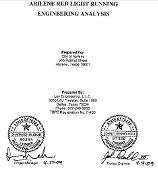5/12/2009
Texas: Study Finds Slim Justification for Camera InstallationReport showing short yellows and other engineering deficiencies slows the march toward red light cameras in Abilene, Texas.

An independent engineering survey found red light cameras would be inappropriate at all but two intersection approaches in Abilene, Texas, results which disappointed city leaders. Last Wednesday, Lee Engineering presented a detailed report to the Red Light Camera Citizen Advisory Committee which had formed in compliance with a 2007 law designed to force officials to think twice before rushing to activate cameras during a budget crunch. The study suggested that engineering improvements might even make cameras unnecessary at those two locations.
"Based on crash and violation data," the study stated, "the report identifies only two approaches that would warrant consideration of photo enforcement in the event that implementation of physical and signal timing changes are unsuccessful at reducing red light running."
Shortened signal timing plagued eleven of the twelve approached identified as the most troublesome by city leaders. The study applied the 1999 guidelines from the Institute of Transportation Engineers (ITE) and found that the calculated change period was too short in these places. The highest violation intersections also happened to have the shortest yellow, with the exception of the Buffalo Gap approach.
The Texas Transportation Institute found that even the 1999 ITE formula produced yellows that were too short, and a 2004 study concluded that adding one extra second of yellow to the minimum calculated value caused a significant decrease in violations and accidents (view study). The state House of Representatives followed the lead of this study and voted last week to impose the extra second of yellow as a legal requirement at any intersection with a camera.
Even with the timing deficiencies, the report found no particular problem with violations in Abilene. The citywide violation rate was lower than the statewide average at every location except Buffalo Gap and Danville/Industrial. At this location, the study found signals were partially hidden, creating a trap for motorists who may not be familiar with the area.
"This restricted visibility was primarily due to the curvature in the roadway, and trees planted in or near the northern right of way along the front of the Texas Department of Public Safety building property," the study explained.
To remedy the situation, the report suggested the installation of "signal ahead" warning signs along with an additional signal head to assist visibility. The report made specific signal timing and engineering recommendations for each intersection. The city has yet to decide whether to proceed with the installation of automated ticketing machines.
"A final decision regarding any further action at these intersections may be taken up by the city council at a later date," a city news release explained last week.
A copy of the full study is available in a 3.5mb PDF file at the source link below.


